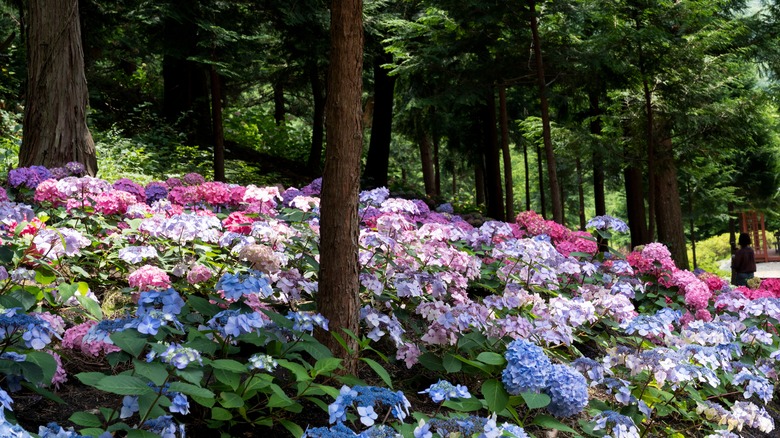Expert Gardener Gives An Important Tip For Planting Hydrangeas On A Slope
Rolling hills are great when they're covered in lush grass, and you can roll down them like a carefree child. But as a gardener, they can often be an unwanted challenge in the landscape. Water rushes down in small yet violent streams, taking sediment with it and causing significant erosion. Many plants can't take the pressure, causing you to either let the grass have it or be in a never-ending cycle of finding something that will be happy there. Hydrangeas look beautiful when layered across a steep slope, and they're actually quite tolerant of sloping conditions. You can use rocks to build up the ground around your plants to ensure they don't get washed away throughout the rainy months, just as gardening expert Jessica Zander from You Can Do It Gardening suggests.
When it comes to watering hydrangeas, keep in mind that they like moist soil but hate wet feet. One of the perks of sloping terrain is that it drains quickly, which is just what hydrangeas are looking for. Keeping hydrangeas happy on a slope is really just a matter of keeping them anchored into the ground, which is where the rocks can be put to use.
Use rocks to build up the slope
Jessica Zander recommends using rocks to build up the soil. A rushing stream of water can remove dirt and nutrients, as she mentions in her TikTok. Zander says, "...put these stones in and kind of bolster the area. You're not going to necessarily put in a whole retaining wall here, but at least around this one plant and any others you have on this slope." In the video, she shows a beautiful sloping terrain with hydrangeas. There are some rocks present, but they don't disturb the area; instead, they help support and take care of the hydrangeas, while enhancing the look and health of the plants.
Zander also shows that you can stack up rocks rather than cut them into the ground. They don't need to be stacked up so high that they create a wall, but making them slightly taller than the soil level will help retain the important nutrients that otherwise would get washed down the slope. Rocks will not only help your soil maintain nutrients, but they can also add some visual interest to a sloping area with little vegetation.
